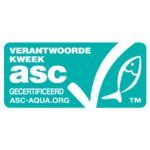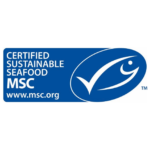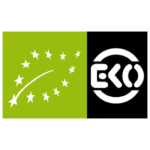Atlantic halibut
Atlantic Ocean, north-west (FAO 21)
Bottom otter trawl, Demersal longlines, Handlines and pole-lines, Gillnets
- Jan
- Feb
- Mar
- Apr
- May
- Jun
- Jul
- Aug
- Sep
- Oct
- Nov
- Dec
Flatfish belong to the order Pleuronectoformes. There are more than 500 species of flatfish. Flatfish live on and partly in the seabed, only the halibut swims higher up in the water column. Flatfish have an oblong, flat shape and their eyes on one side. The upper-side, the eye-side, of the flatfish has a camouflage colour and the underside is white. It may seem like flatfish swim on their belly, however, in fact, they are laying on their side. Flatfish larvae have a regular fish shape, with eyes on each side and a vertical swimming mode. After 6 weeks, one of the eyes migrates upwards, over the head to the other side. From now own, the flatfish swims with their eyes up and their blind side facing the seabed.
The best known flatfish species in the Netherlands are sole and plaice. Other flatfish species that occur in the North Sea are the common dab, halibut, turbot, brill, European flounder and lemon sole. Flatfish are caught with beam trawls, pulse trawls or demersal otter trawls.
The Atlantic halibut is found in the northern Atlantic Ocean. This species lives near the seafloor, often at depths between 50 and 2000 metres. They occasionally hunt at lesser depths for squid. This species of halibut has a lifespan of up to 50 years and reaches lengths of 4.70 metres. These fish then weigh around 320 kilograms.
Atlantic Ocean, north-west (FAO 21)
Bottom otter trawl, Demersal longlines, Handlines and pole-lines, Gillnets
Atlantic Ocean, northeast (FAO 27)
Demersal longlines
Atlantic Ocean, northeast (FAO 27)
Gillnets
Atlantic Ocean, northeast (FAO 27)
Demersal longlines
Iceland grounds (FAO 27)
Bottom otter trawl
Atlantic Ocean, northeast (FAO 27)
Deelgebieden: Barents sea
Demersal longlines
Atlantic Ocean, northeast (FAO 27)
Deelgebieden: Barents sea
Bottom otter trawl

Fish with the ASC label is farmed in a sustainable manner.

Fish with the MSC label is caught sustainably.
This fish is not being overfished or is being responsibly farmed, with minimal impact on the environment.
This fish is a second choice. There are still some improvements to be made in this fishery or fish farm.
Do not buy this fish. It's being overfished or the way it's farmed or caught has a negative impact on the environment.

There is fish available of this species that is farmed or caught using high welfare standards.

GlobalG.A.P. certified farms are doing a step in the right direction in terms of sustainability. A few species with this label are getting a better score on the VISwijzer.

Organic standards are the strictest when it comes to fish feed. They also require certain measures for animal well-being.